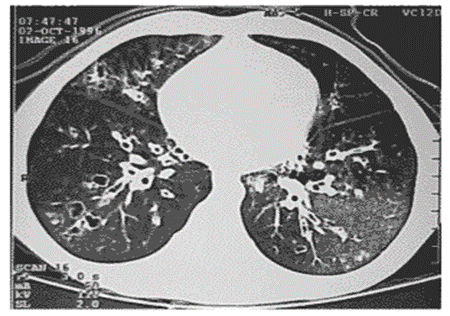Respiratory
Bone Marrow Transplant Related Toxicity
Children undergoing stem cell transplant are at risk for late pulmonary damage from:
- Chemotherapy – most commonly Busulfan
- Radiation therapy (RT)- usually total body irradiation (TBI)
- Infection
- Infections usually occur early in the post transplant course but may be associated with late toxicity if they occur in the setting of graft versus host disease
- Immune mediated damage (Graft versus Host Disease)
Lung toxicity occurs in approximately 30-60% of patients after allogenic hematopoietic stem cell transplantation (allo-HSCT)10.
There are two forms of chronic pulmonary dysfunction common in patients surviving greater than 100 days following allo-HSCT9:
- Obstructive Lung Disease (OLD)
- Due to collagen deposition and development of fibrosis in peribronchiolar space
- Restrictive Lung Disease (RLD)
- Due to collagen deposition and development of fibrosis in interstitial tissues8.
Clinical Factors Present in OLD versus RLD8
Clinical Factor |
Obstructive Lung Disease (OLD) |
Restrictive Lung Disease (RLD) |
Diagnostic entity |
BO (Bronchiolitis obliterans) |
BOOP (BO organizing pneumonia) |
Onset |
Late (3-12 months) |
Early (within 3 months) |
Symptoms |
Dyspnea, nonproductive cough |
Dyspnea, non productive cough |
Physical exam |
Wheezing |
Rales |
Pulm Fxn Tests FEV1/FVC TLC DLco |
Obstructive Physiology Decreased Normal Decreased |
Restrictive Physiology Normal Decreased Decreased |
CT scan findings |
|
|
Lab Data |
Nonspecific |
Increased CRP Peripheral neutrophilia |
Chronic GVHD |
Strong association |
Variable, positive with BOOP |
Therapy |
Not responsive to corticosteroids |
Responsive to corticosteroids |
Bronchiolitis Obliterans (BO)
The most common and recognizable form of OLD is bronchiolitis obliterans (BO).
This a serious life threatening manifestation of chronic graft versus host disease (cGVHD).
The presence of BO after allo-HSCT is on its own diagnostic of cGVHD.11
BO is characterized by an inflammatory process resulting in:8
- Bronchiolar obliteration
- Fibrosis
- Progressive OLD
CT scan of chest from individual with bronchiolitis obliterans as a manifestation of cGvHD. Note large dilated airways:

Symptoms of BO:
- Patients can be asymptomatic early in the disease process
- Usually presents with:
- cough
- wheezing
- dyspnea on exertion11.
PFTs in BO:
PFTs will show obstructive lung disease with:
- General preservation of forced vital capacity (FVC)
- Decreases in forced expiratory volume in 1 sec (FEV1 )
- Associated decrease in FEV1 /FVC ratio
- With or without significant declines in the diffusing capacity of lung for carbon monoxide (DLco)8
Treatment of BO:
Currently, there are no effective therapies for BO, and patients frequently develop progressive and debilitating respiratory failure despite initiation of enhanced immunosupression.8
In one series, five year survival rates for cGVHD triggered BO patients at 5 years was only 10% compared to 40% for patients that did not develop BO.41
Bronchiolitis obliterans organizing pneumonia (BOOP)
BOOP is the most recognizable form of RLD after allo-HSCT.8
Clinical signs and symptoms include:8
- Dry cough
- Shortness of breath
- Fever
- Radiological findings:
- Diffuse, peripheral, fluffy infiltrates consistent with airspace consolidation
BOOP occurs in less than 10% of allo-HSCT patients although the development of BOOP is strongly associated with prior acute and chronic GVHD.13
Investigations to differentiate BO, BOOP, and Infection related lung damage:
1. High resolution CT of chest - may identify and infectious process or air trapping
2. Serial complete PFTs assessing lung volumes, spirometry and DLco
3. Broncho-alveolar lavage may identify concurrent infection requiring aggressive treatment8
4. Lung biopsy may be needed for definitive diagnosis – often avoided because of risks of bleeding, pneumothorax and the need for general anesthesia.
Therapy:
- Corticosteroids
- Enhanced immune suppression for GVHD
- Inhaled corticosteroids
- Bronchodilators
- Supplemental oxygen
- Pulmonary rehabilitation
- Aggressive treatment of infections
- Prophylaxis against Pneumocystis
- Treatment of gastroesophageal reflux
- Smoking cessation

